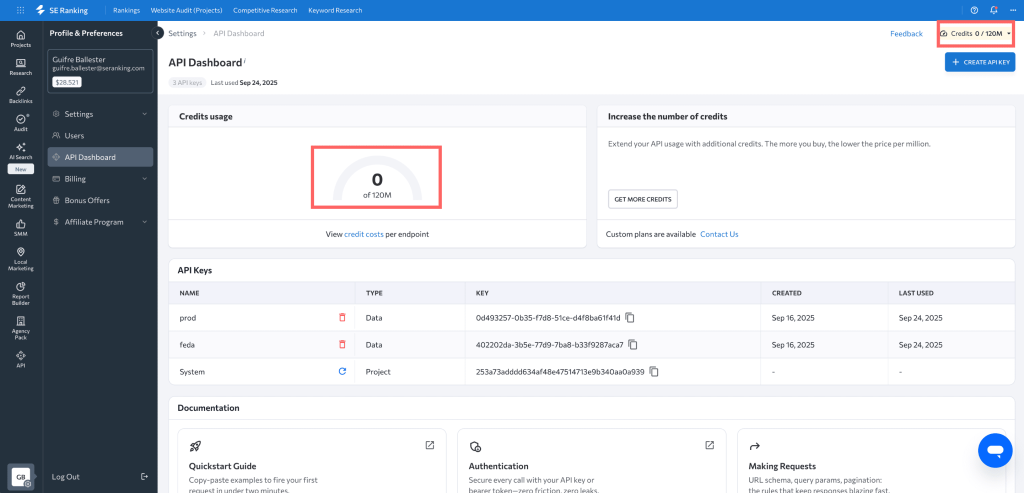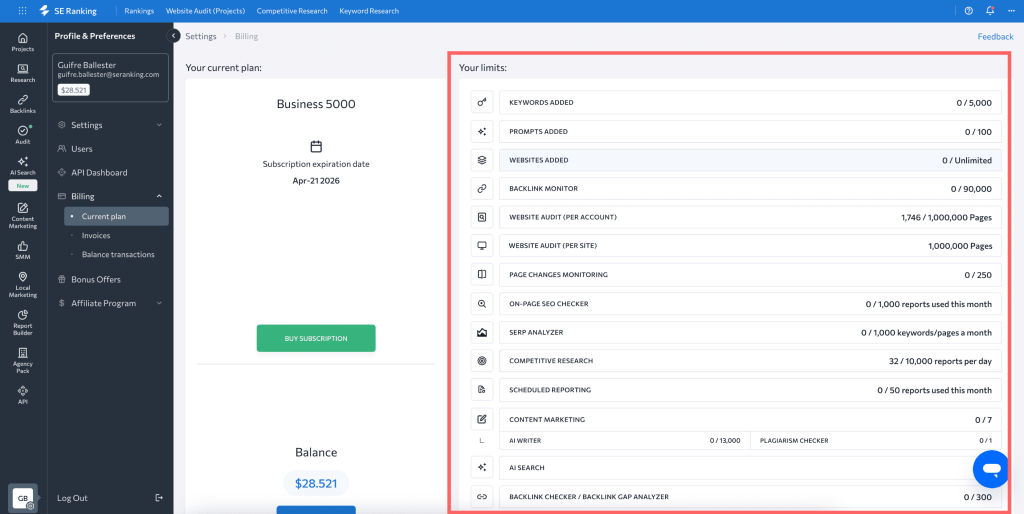API credit system
SE Ranking provides two distinct APIs: the Data API, which uses a pay-as-you-go credit system for raw data retrieval, and the Project API, which utilizes your standard subscription limits for project management. This guide explains how consumption is monitored and calculated for both.
Check balance and limits
Data API credits
The Data API operates on a flexible credit system. Plans start at 1 million credits. If you run out of API credits, you can buy more on the API Dashboard or contact us at [email protected]. To learn more, refer to our guide Getting API access.
Make sure your credit balance is sufficient before making requests. You can check your remaining credits in two ways:
In the API dashboard
Navigate to Profile & Preferences > API Dashboard. Your current balance is displayed prominently in the Credits usage visualization and in the top-right header of the SE Ranking interface.

By using an API call
You can programmatically check your balance using the following endpoint in the Data API:
/v1/account/subscription
Cost: 0 credits
This request returns the number of remaining API credits and details about your current plan to help you manage usage.
Request parameters
| Parameter | Type | Mandatory | Default | Description | Example |
|---|---|---|---|---|---|
| apikey | String | Yes | N/A | Your API key in UUID format. For more information, see Authentication. | 80cfee7d-xxxx-xxxx-xxxx-fc8500816bb3 |
| output | String | No | json | Output format (json or xml). | json |
Response parameters
| Parameter | Type | Description | Example |
|---|---|---|---|
| status | String | Current status of the API subscription plan: active, inactive, expired, or disabled. | active |
| start_date | Datetime | Subscription start date in YYYY-MM-DD HH:MM:SS format. | 2025-05-07 15:10:27 |
| expiration_date | Datetime | Subscription expiration date in YYYY-MM-DD HH:MM:SS format. | 2026-05-07 15:10:27 |
| units_limit | Long | Quota (total number of API units) for this subscription. | 50000000 |
| units_left | Long | Current API balance, i.e., number of API units left. | 123546 |
Request example (cURL)
curl -X GET 'https://api.seranking.com/v1/account/subscription' \
-H 'Authorization: Token YOUR_API_KEY'
Response example (JSON)
{
"subscription_info": {
"status": "active",
"start_date": "2024-01-18 14:20:02",
"expiraton_date": "2024-02-18 14:20:02",
"units_limit": 5000000,
"units_left": 4975033
}
}
Project API limits
The Project API consumes the limits associated with your standard SE Ranking subscription plan rather than separate credits. You can check your account’s specific usage limits under Profile & Preferences > Billing, in the Your limits section.

Consumption
To effectively manage API usage, it is crucial to understand how credits (Data API) or limits (Project API) are consumed.
How Data API credits are consumed
Every successful API call (i.e., one that returns a 2xx status code) consumes a specific number of credits from your balance. Failed requests (4xx or 5xx errors) are always free and do not consume credits.
Different API reports have varying costs based on two billing models:
- Cost per Record: Credits are charged for each individual record returned in the response (e.g., each backlink, keyword, or domain). The total request price is calculated based on the total number of lines returned.
- Cost per Request: A flat number of credits is charged for each successful API request, regardless of the amount of data returned.
How Project API limits are consumed
The Project API does not use credits. Instead, it consumes the limits of your SE Ranking subscription. Any action that consumes a limit within the SE Ranking platform will also do so when performed via the API.
For example:
- An API call to add a keyword will count against your plan’s “Keywords added” limit.
- Initiating an audit via the API will consume “Pages” available in your plan’s “Website Audit” limit.
Forecasting and optimization
Check API request price
You can check how many credits are consumed for each Data API endpoint either in the description of each endpoint or in the endpoint credit costs table.
Forecasting Data API costs
Before running a large-scale workflow, we recommend forecasting the credit cost to avoid interruptions.
- List the calls in your workflow.
- Multiply each call by its credit cost using the Data API endpoint credit costs table.
- Sum the costs for all calls.
- Compare the total with your
credits_left(obtained via the/v1/account/subscriptionendpoint).
Cost calculation example:
Suppose you need backlink summaries for 250 domains and a full export for one of them.
/backlinks/summary(Cost per Record):- You request data for 250 domains (250 records).
- Cost: 250 records × 100 credits = 25,000 credits.
/backlinks/exporttask creation (Cost per Record):- You request data for 250 domains.
- These domains have 50,000 backlinks (records).
- Cost: 50,000 records × 1 credit = 50,000 credits.
/backlinks/export/statuspolling (Cost per Request):- Checking the status (e.g., twice).
- Cost: 2 calls × 0 credits/request = 0 credits.
Total estimated cost: 25,000 + 50,000 + 0 = 75,000 credits.
Insufficient funds or limits
Data API errors
If your balance is too low to fulfill a request, the API will return an error, and no credits will be charged.
If you do not have enough API credits for the requested number of records or the request itself, the API will return an HTTP 403 Insufficient funds error.
To replenish your balance, visit the API Dashboard to upgrade your plan or contact our support team at [email protected] to enable overage billing.
Response example (JSON)
{
"error": {
"code": 403,
"message": "Insufficient funds",
"description": "Your current credit balance is too low to process this request."
}
}
Project API errors
If you attempt an action via the Project API (such as adding a keyword) that exceeds your subscription limits, the API will return an error indicating the specific limit has been reached.
To replenish your balance, visit the Subscription Page to upgrade your plan or contact our support team at [email protected].
